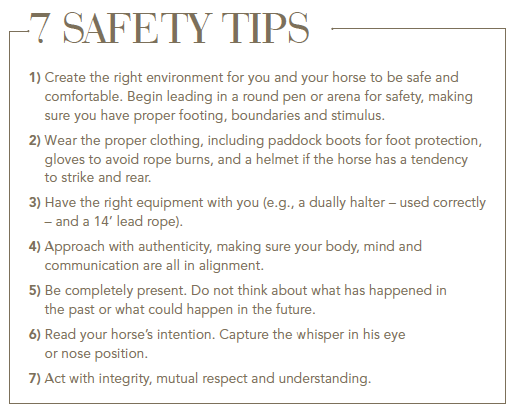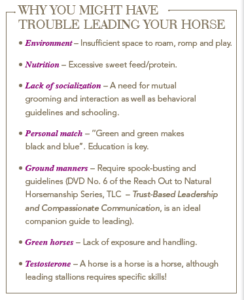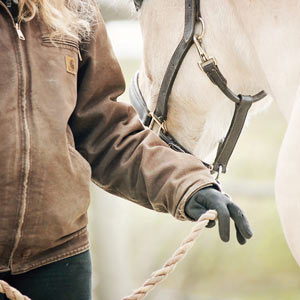He was exquisite, a true specimen of majesty and beauty. I watched as the three-year-old black Friesian stallion quickly paced back and forth in the tiny stall he had to call home. With testosterone and energy coursing through his body, he barely knew what to do with himself. He was clearly uncomfortable cooped up in his small pen and I wondered how often he was able to spend time outside playing, exercising and just being a horse. It didn’t take long to recognize that he was a victim of mishandling.
This amazing fellow was being trained for a judging event called Keuring. But with an inexperienced guardian and a young trainer, things weren’t going quite as planned. I was called in to assist because the barn staff was very concerned about the safety of both horse and humans, and I could see why. My visit was short, as I had flown in from out of state to consult. With just an hour to assess, advise and potentially “fix” this predicament, I knew I had my work cut out for me.
I don’t believe there is such a thing as a “bad” horse, but dangerous horses can quickly be created when they are misunderstood or mishandled. Mishandling can take on many different forms, including force and abuse, and lack of experience in identifying correct boundaries and behavior patterns.
 WHO IS LEADING WHO?
WHO IS LEADING WHO?
As with most of my consultations, I asked for the guardian to handle the horse so I could observe their interactions. My client began to enter the stall, but quickly came back out as she wasn’t comfortable in her horse’s presence. Overexcited and unpredictable, he was simply too much for her to handle.
I then asked the trainer to lead the stallion to the arena so I would have a chance to observe the training. The stallion crowded the doorway. The trainer smacked the horse in the face to ask him to back up, placed the halter on and then led him comfortably to the arena, where she handed him over to the guardian.
He immediately engaged in a full battery of ornery and mischievous behavior. He was pulling my client in every direction, swinging his head, almost knocking her over, nibbling on her, trying to take a chunk out of her side. With all this happening, there was no chance for the guardian to lead him around the arena. Instead, she spent her time trying to avoid being stepped on, body slammed and bitten. Her attention was on staying safely out of her horse’s way, and not giving him clear direction as the leader of her herd of two. It was abundantly clear who was leading whom.
 THE CHANGE COMES FROM YOU
THE CHANGE COMES FROM YOU
I asked the stallion’s guardian why she was having trouble, and she told me she didn’t want to offend him by schooling him. But her concern over not offending him had overshadowed her own safety and ability to be a true leader.
Next, I began working with the stallion. Through reading his facial features, energy and body language, it was apparent after only a short time that this young horse wasn’t malicious. He had learned to be disrespectful due to mishandling. His eye remained soft, his top lip extended in a mischievous manner, and the rest of his body and energy were playful, not aggressive. But this playfulness could change in a heartbeat and was only a thought away! We discussed the use of the Dually, a pressure halter I endorse and utilize in my practice. We switched halters, which in itself was quite the task. It was like trying to halter a piranha!
From my confident approach, the stallion knew this experience would be very different and immediately took a step back. It only took a few minutes to teach him to stand at attention, create space, and remain attentive, polite and respectful. In fact, he was so good that I was taken aback by this instant transformation.
My expectations were clear: “You don’t hurt me and I don’t hurt you, and together, we can realize your full potential!” We made great progress as he proudly displayed his knowledge of “ground tying”. Next, we moved into leading around the full arena with length in the line, right down to the mirror that had previously scared him at both a walk and trot in-hand. In only a single one-hour session, he was an entirely different horse.
 CREATING A TEAM
CREATING A TEAM
But a responsible trainer always remembers that no matter how good the horse is, if the client isn’t on the same page, she can easily undo all the work that was done. It is important to make sure that the horse owner or trainer can carry on your work and not confuse the horse with mishandling or inconsistent training and communication, and to teach the guardian the lessons she needs to carry this success into the future.
As I watched my client learn from observation, and then later with personal guidance, I was proud to see a team developing right before my eyes. All it took was just a few corrections for both parties to understand acceptable and unacceptable behavior, and for everyone to remain safe and enjoy each other’s company. We started the day with a case of mishandling, and ended with a partnership and winning team!
Anna Twinney is the founder of Reach Out to Horses®. She is known around the globe for her highly acclaimed work as an Equine Specialist, Natural Horsemanship Clinician, Animal Communicator and Karuna Reiki Master. Her gentle yet highly effective methodologies are based exclusively in the horse’s own language, including non-verbal communication, animal communication and the use of energy. Anna began her career as a natural horsewoman with the legendary Monty Roberts. She was the first Head Instructor of the International Monty Roberts Learning Center before developing the ROTH Methodologies and creating Reach Out to Horses. For more information, check out the “Reach Out to Horses Video Introduction” at ReachOutToHorses.com.







